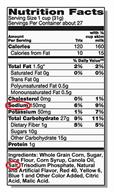ThisisPatientEngagementcontent
Cooking With Less Salt
Learn more about our Patient Engagement products now! Turn your patients into active participants in their healthcare by giving them easy access to the same evidence-based information you trust – but delivered in an easy-to-understand format.
Cooking with less salt is one way to reduce the amount of salt (sodium) you get from food. Most people should have less than 2,300 milligrams (mg) of sodium each day. If you have high blood pressure (hypertension), you may need to limit your sodium to 1,500 mg each day. Follow the tips below to help reduce your sodium intake.
Reading food labels

Shopping
Cooking
Meal planning
The sodium in bread can add up. Try to plan meals with other grains. These may include whole oats, quinoa, whole wheat pasta, and other whole grains that do not have sodium added to them.
Vegetables
Regular canned vegetables, except low-sodium or reduced-sodium items. Sauerkraut, pickled vegetables, and relishes. Olives. French fries. Onion rings. Regular canned tomato sauce and paste. Regular tomato and vegetable juice. Frozen vegetables in sauces.
Grains
Instant hot cereals. Bread stuffing, pancake, and biscuit mixes. Croutons. Seasoned rice or pasta mixes. Noodle soup cups. Boxed or frozen macaroni and cheese. Regular salted crackers. Self-rising flour. Rolls. Bagels. Flour tortillas and wraps.
Meats and other proteins
Meat or fish that is salted, canned, smoked, cured, spiced, or pickled. Precooked or cured meat, such as sausages or meat loaves. Bacon. Ham. Pepperoni. Hot dogs. Corned beef. Chipped beef. Salt pork. Jerky. Pickled herring, anchovies, and sardines. Regular canned tuna. Salted nuts.
Dairy
Processed cheese and cheese spreads. Hard cheeses. Cheese curds. Blue cheese. Feta cheese. String cheese. Regular cottage cheese. Buttermilk. Canned milk.
The items listed above may not be a full list of foods high in sodium. Talk to a dietitian to learn more.
Fruits
Fresh, frozen, or canned fruit with no sauce added. Fruit juice.
Vegetables
Fresh or frozen vegetables with no sauce added. "No salt added" canned vegetables. "No salt added" tomato sauce and paste. Low-sodium or reduced-sodium tomato and vegetable juice.
Grains
Noodles, pasta, quinoa, rice. Shredded or puffed wheat or puffed rice. Regular or quick oats (not instant). Low-sodium crackers. Low-sodium bread. Whole grain bread and whole grain pasta. Unsalted popcorn.
Meats and other proteins
Fresh or frozen whole meats, poultry that has not been injected with sodium, and fish with no sauce added. Unsalted nuts. Dried peas, beans, and lentils without added salt. Unsalted canned beans. Eggs. Unsalted nut butters. Low-sodium canned tuna or chicken.
Dairy
Milk. Soy milk. Yogurt. Low-sodium cheeses, such as Swiss, Monterey Jack, mozzarella, and ricotta. Sherbet or ice cream (keep to ½ cup per serving). Cream cheese.
Fats and oils
Unsalted butter or margarine.
Other foods
Homemade pudding. Sodium-free baking soda and baking powder. Herbs and spices. Low-sodium seasoning mixes.
Beverages
Coffee and tea. Carbonated beverages.
The items listed above may not be a full list of foods low in sodium. Talk to a dietitian to learn more.
Herbs, seasonings, and spices can be used instead of salt to flavor your food. Herbs should be fresh or dried. Do not choose packaged mixes. Next to the name of the herb, spice, or seasoning below are some foods you can pair it with.
Herbs
Seasonings
Spices
This information is not intended to replace advice given to you by your health care provider. Make sure you discuss any questions you have with your health care provider.
Cookies are used by this site. To decline or learn more, visit our cookie notice.
Copyright © 2025 Elsevier, its licensors, and contributors. All rights are reserved, including those for text and data mining, AI training, and similar technologies.